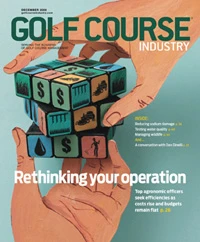My Blackberry – yes, I’ve finally given in and become one of those information-crazed, PDA-toting dweebs – buzzed incessently the night of November 4 and the morning of November 5.
As people from throughout the golf industry responded to the outcome of the presidential election, the messages, texts and e-mails ranged from “I’m moving to Canada!” to “I can’t believe we’ve become a socialist nation!” to “It’s the end of the world as we know it.” But, the main theme was, “This is going to be terrible for the golf business.”
I was tempted to reply, “Oh my, the sky is falling!” and hit “send all” on my cursed communication device to all of the Chicken Littles out there.
But, I resisted that temptation because, like many of you, this isn’t my first rodeo. I’ve been through this before, and we’ll probably go through it again.
My friends – as John McCain is overly fond of saying – let me tell you one thing about the outcome of the 2008 presidential election that I well and truly know for sure: The sky isn’t falling on the golf industry.
First, let me be clear: The sky is most definitely sagging over American business in general. It isn’t going be pretty for anybody for a few years. But it’s largely understood that no president is bigger than a global economic cycle. Basically, we’re all in the same boat for a while no matter who’s the captain.
I don’t think the Obama administration will be better for small to mid-sized businesses, such as golf courses. There’s no question for-profit operators will see tax increases of some kind or at least a rollback of Bush’s tax cuts. But I don’t believe we’re any more likely than anyone else to be on the White House’s hit list for more regulation or special disfavor. It’s not as if golf – like the insurance or petroleum industries – actively opposed his candidacy through political action committees or other institutional efforts. Hell, even if we wanted to try something like that, we’re just not organized enough to do it.
The bottom line is that this new administration, most assuredly, has bigger fish to fry than us. Also, remember the industry brouhaha that accompanied Bill Clinton’s election in 1992? His liberal agenda supposedly included putting Al Gore in charge of the EPA and letting him eliminate pesticides and tightly regulate “resource wasters,” such as golf. Gee, you know what? That didn’t happen. Instead, golf grew dramatically, and we made inroads with the government and began to carve out a reputation as relatively good environmental citizens.
My sense is that, like Clinton, Obama may be more of a centrist when it comes to business and the environment. I hope I’m right. The real risk comes from Congress, but that’s another column for another time.
The other thing that’s happened since 1992 is that we’ve made significant improvements in our environmental performance. Most of the chemistry used now is superior, less toxic and much less mobile or persistent. Water management technology and “smart” genetically improved turfgrasses also have advanced tremendously. We’ve fixed almost all of the gaping holes in our eco-friendly story, and that will serve us well.
Recently, I interviewed the chief of EPA’s nonpointsource pollution division regarding its concerns about the green industry. Pesticides and fertilizers barely figured in the conversation. Their main problem with lawns is they tend to be part of nonpermeable developments. In short, rainfall hits them, runs off in massive quantities and erodes streams and watersheds without having a chance to recharge groundwater. Guess what golf courses tend to do really well? Act as big-ass recharge basins for groundwater.
And, to give credit where it’s due, the GCSAA has done a pretty fair job of staying in front of the EPA and other regulators with environmentally positive messages. When the time comes for the administration to start pointing out good guys and bad guys, I’m pretty sure we’ll make the “nice” list instead of the “naughty” list.
Finally, the allied golf community has, at long last, gotten off its collective keister and started promoting the remarkable economic impact of our industry on Capitol Hill. The PGA Tour, PGA of America, GCSAA and other organizations seemed to have a good first round earlier this year with the National Golf Day concept.
And, despite other reservations I have about Tour commissioner Tim Finchem, he’s the defacto leader of this effort, and you can’t deny he knows his way around the Beltway. After all, that’s where he got his start before landing in the commish job.
So, it may be a bit dreary and overcast right now, but the sky remains plenty high above our heads. But remember, Chicken Little got bonked on the head by an acorn or two in that old kid’s story. I fully expect acorns from local and state governments will continue to drop unexpectedly on our noggins from time to time. The risk to us is that we worry so much about the danger from the sky, we forget about those acorns that could still knock us silly if we’re not paying attention. GCI
Pat Jones is president of Flagstick LLC, a consulting firm that provides sales and marketing intelligence to green industry businesses. He can be reached at psjhawk@cox.net or 440-478-4763.

Explore the December 2008 Issue
Check out more from this issue and find your next story to read.
Latest from Golf Course Industry
- Heritage Golf Group acquires North Carolina courses
- Editor’s notebook: Green Start Academy 2024
- USGA focuses on inclusion, sustainability in 2024
- Greens with Envy 65: Carolina on our mind
- Five Iron Golf expands into Minnesota
- Global sports group 54 invests in Turfgrass
- Hawaii's Mauna Kea Golf Course announces reopening
- Georgia GCSA honors superintendent of the year





